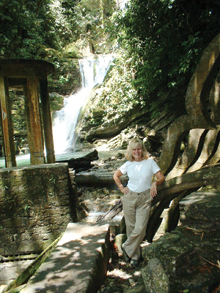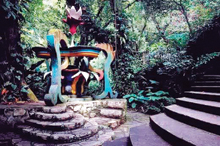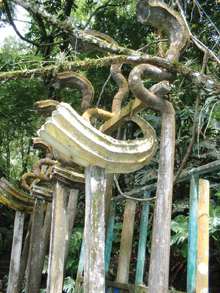People
June 7, 2010
First Person: Discovering a lost Surrealist masterpiece

Camille Cottrell on a 2005 expedition to Las Pozas.


Camille Cottrell is associate professor of art history and studio art at Oxford College.
Most academic research takes the scholar down a path which, hopefully, leads to discovery. My current inquiry, however, has taken the opposite approach. It began with a fortuitous discovery which has since led me to investigate a previously unrecognized genius of the Surrealist Art Movement: Edward James.
My husband and I have what we refer to as “let’s go here moments.” These impulses have led us to explore a crumbling Victorian cemetery outside of London, to look down on the rain forest canopy from the top of an overgrown Mayan pyramid in Guatemala and to explore abandoned ruins in New York. These experiences have served as inspiration for our artwork, and the photos we took (mostly with disposable, one-use cameras) are incorporated into many of our mixed media pieces. (Thanks to Oxford’s IT department, we are now equipped with digital technology!)
In 2005, however, our “let’s go here” moment led to an amazing discovery which has become the focus of our research into the forgotten Surrealist masterpiece Las Pozas and its creator, Edward James.
My husband, George Kennedy, was digging through dusty old guidebooks in a used book store when he came upon a grainy photo of bizarre concrete sculpture seemingly growing out of the jungles of Mexico. We had to go.
So we mounted an expedition starting in Tampico, Mexico. After seven harrowing hours of travel over some very rugged terrain, we arrived at the tiny town of Xilitla and the beginning of an incredible journey of discovery.
Edward James (1907-84) was an eccentric British millionaire who is perhaps best remembered as a minor poet and patron of the arts. An early exponent of Surrealism, he financially supported Dali, Magritte and other surrealists in the early 1930s and hosted the First International Surrealist Exhibition in Britain in 1936. During these years he amassed what is recognized as the world’s greatest private collection of Surrealist art.
While his early support of the Surrealists is well documented, his greatest work is barely known and remains largely ignored by art historians.
Hidden in the remote heights of the Sierra Madre Oriental, in a jungle paradise which is barely accessible even today, James spent 35 years creating a sculpture garden of unsurpassed beauty and weirdness. It is called Las Pozas.
With his partner, guide and friend, Plutarco Gustalem, he employed an entire village to create towering spires, staircases to nowhere, giant orchids and other sculpture which defies description over an 80-acre site surrounding a magnificent waterfall.
Because of its remote location and because James cared little for publicity or recognition by the art world, Las Pozas has remained a curiosity, the jungle folly of a rich fool. Until now.
Inspired by these fantastic images of the dream state realized in poured concrete, I began looking at Edward James through the lens of scholarship as well as through the eyes of an artist. During our 2005 expedition to the site, we took extensive photos and conducted preliminary interviews with descendants of the Gustalem family.
We have since undertaken further research, generously funded by a grant from Oxford alumnus Eugene Rackley III ’55Ox-’58BBA. This investigation took us first to the Dali Museum archives in St. Petersburg, Fla., then to the private reading room of the Morgan Library in New York where we read correspondence between James and the influential art dealer Pierre Matisse and noted Surrealist painter Leonora Carrington. In an attempt to trace the etymology of his imagery, his creative process and the evolution of his artistic philosophy, in 2009 we went to James’ ancestral estate, West Dean in Sussex, where we sifted through 24 boxes of his personal correspondence.
Our investigation to date has made it clear that Las Pozas was not realized as a single, cataclysmic event, but rather, was the culmination of an evolutionary process that spanned James’ entire life. In his early days he championed Surrealism for its celebration of personal exploration, freedom of expression and individual genius. As he matured, James’ desire to reveal the subconscious through the juxtaposition of fantastic imagery found form in his art, bringing the metaphysical into the realm of the physical.
The Surrealist Movement, which celebrated the illogical inspiration of the unconscious and embraced biomorphism as recognition of the continual state of change occurring in all life forms, was, for Edward James, more than merely an artistic “manifesto.” He found in it a vehicle for expressing his lifelong search for freedom and personal redemption through the creative process.
Although he had severed his ties with the Surrealists by the time his masterpiece was fully under construction, James accomplished a biomorphic merging of nature with sculpture, art with architecture, and landscape with the landscape of the mind which stands as perhaps the most complete realization of Surrealism’s ideals.
Since my initial trip to Las Pozas, the site has been purchased by Fondo Xilitla, a foundation set up for the purpose of preserving this fantastic work of art. Our planned return to the site in 2009 had to be postponed due to the H1N1 influenza outbreak, but it is my sincere intent to return to the site to continue my research and take further steps to establish the posthumous reputation of Edward James as the great Surrealist artist that he was.
